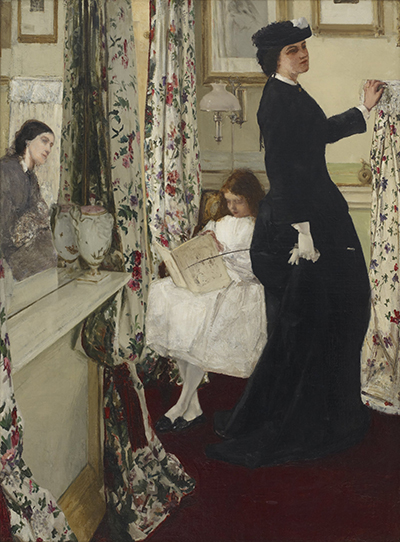Despite living in the era where artwork faced serious criticism, Whistler’s work in painting Harmony in Green and Rose: The Music Room is a painting to adore. Whistler introduced new paradigms in his paintings which received major backlash as a profession.
This painting sits between impressionism and post-impressionism due to the strong controversy that preceding paintings had caused. However, this artwork incorporated adorable techniques, styles, and sense of beauty. Whistler was loved by the symbolists since they appreciated his artwork all the time. The Harmony in Green and Rose: The Music Room was motivated by the symbolists who believed in Whistler’s work. Whistler was a prominent member of Aesthetic Movement. Aesthetics was defined as the study of emotions and mind in relation to sense of beauty in literature and other fine arts. Therefore, Whistler used Aesthetics as the basis of his painting during preparation stage of this painting.
Whistler used stringent methodology when painting this artwork. He personally described his painting style as science. He described his style as combination of knowledge and understanding in paint and brushes. He taught this unique style in Paris for many years at the Acadimie Carmen. His style did not aim to copy nature but selectively extracted simple elements of nature to create beauty. His style included ensuring picture frames and interiors of exhibition rooms formed integrated artistic concept.
Arthur J. Edddy was Whistler’s sister and she is the only person that knew how to describe his painting technique. According to her description, whistler used thin colours covered with canvas and innumerable coats of paint. The density of the colour increased as the work progressed from greyish-brown to a complete blend of fresh greyish-brown background. He would intensify the background then the image and back to the background for long hours with great rapidity.
Whistler used oil and canvas to paint almost every artwork. These were the most used media since they were easily available, had a fine texture, and highly durable. This portrait is a collection of Freer Gallery of Art and measures 96.3 cm height by 71.7 cm width. Whistler left the Courbet's Realism and developed his own signature style in painting. He was inspired by Edouard Manet's passion in exploring limitations and possibilities of paint. His work inspired many art students whom he taught his unique styles in Paris. Currently, the painting is in the USA as a property of Freer Gallery of Art.




